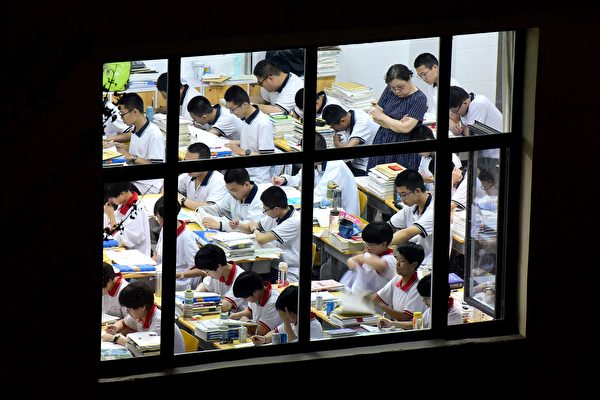The Chinese Communist authorities have implemented a national weekend break for high school students, a seemingly simple issue that has encountered significant resistance. Experts say that as long as the political system and educational structure remain unchanged, implementing a weekend break for high school students in China is just wishful thinking.
No country’s students face as much pressure as Chinese high school students do. From around 6 am until 10 pm, studying for 16 hours a day is the norm for Chinese high school students, especially in populous provinces with scarce higher education resources.
There is significant regional discrimination in the college entrance exam (Gaokao), with students in some provinces needing to put in greater effort. For example, in Hubei, with a population five times that of Beijing, students must score 160 points higher than Beijing students to enter Tsinghua or Peking University. Meanwhile, students in Sichuan can only attend third-tier institutions, while with similar grades in Beijing, they could easily enter first-tier universities.
With extremely low admission rates at 985 and 211 universities, teachers and parents act as “accountants,” calculating the input-output ratio of every minute and second. High school students are ingrained with the concept of “scores,” where even a one-point difference can mean the difference between passing or failing.
This anxiety has led to the rise of a super “exam-oriented” education institution known as the “Gaokao Factory” – Hengshui Middle School in Hebei Province. There, only elite classes exist, there are no regular classes, and every classroom is equipped with HD cameras monitoring students’ every move, even during meals and sleep, with seamless schedules planned out meticulously.
Although Hengshui’s “boot camp” approach and drill-and-practice tactics have been criticized for stifling creativity, the school has achieved a significantly higher one-tier college admission rate compared to regular high schools, prompting schools from Shandong, Hunan, Hubei, Sichuan, and other areas to emulate this model.
This “factory-style” time management severely impacts the mental health of high school students. According to the “Chinese National Mental Health Development Report (2019-2020),” 84.1% of high school students sleep less than 8 hours per day, averaging only 7.2 hours. The “2023 China Mental Health Blue Paper” shows that the depression detection rate among Chinese high school students is as high as 40%.
Observing mainland high school students, it is noted that the happiest and most relaxed moments for them are during physical education classes and the free time after dinner. Only then can one see the “youthful essence” they should possess.
Zhang Lufan, who has studied in mainland China, reveals that during high school, there were depression tests conducted at school, with teachers mentioning that the depression rate among her classmates was around 30% to 40%.
Lufan describes the strict daily schedule in high schools in China, where students have little to no personal time, especially highlighting the rigorous routine in rural schools with wake-up calls at 4 am, constant classes, and only minimal breaks.
Zhang Jishun from Henan, China, reflects on the intense schedule his child had in high school, with little to no downtime even on weekends. The burden of heavy homework and school tasks left no room for relaxation, illustrating the suffocating educational environment prevailing in many Chinese schools.
In an unexpected move, the Chinese Ministry of Education and multiple administrative departments announced the implementation of weekend breaks for high schools starting from the fall semester of 2025. However, the sudden nationwide implementation of weekend breaks in high schools this spring term has raised questions and concerns among students and educators.
Facing this abrupt change, many have questioned why high schools across the country suddenly started implementing weekend breaks without prior notice. Online posts discussing the issue have spread widely, prompting discussions on the reasons behind this unexpected shift.
One commentator suggested that sensitive data like student suicide rates are kept under wraps and not openly disclosed, leading to surprises like the sudden implementation of weekend breaks. The commentator highlighted the alarming statistics concerning student suicides and depression rates, urging immediate action to curb these issues.
Despite the rollout of weekend breaks in high schools across many regions in China, the implementation has faced significant resistance and challenges.
The inconsistency in implementing weekend breaks has also been observed in various provinces, with schools finding ways to circumvent the policy to maintain their desired schedule and practices.
Critics argue that simply instituting a weekend break without addressing the root causes of high-stakes exams and unequal opportunities in the education system is a superficial solution.
The debate over the benefits of weekend breaks for students in China has revealed deep divisions among educators, parents, and schools. The pressure to excel in the fiercely competitive education system, especially with the looming college entrance exams (Gaokao), poses a significant barrier to the full-fledged implementation of weekend breaks in high schools.
The resistance to weekend breaks highlights the entrenched challenges within China’s education system, with concerns over academic competitiveness, school rankings, and the relentless pursuit of academic excellence overshadowing the welfare of students.
As the discussions on weekend breaks continue, it becomes apparent that real change requires addressing the systemic issues underlying the intense academic environment in Chinese high schools. Only by tackling the core problems of the education system can meaningful reforms be instituted to promote student well-being and holistic development. The journey towards creating a more balanced and nurturing educational environment in China remains an ongoing challenge that necessitates a holistic approach and collaborative efforts from all stakeholders involved.

